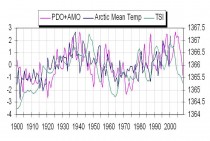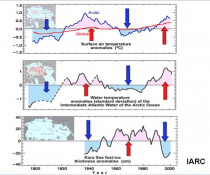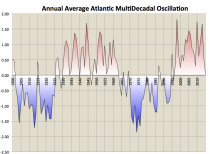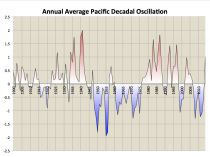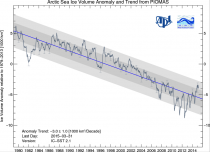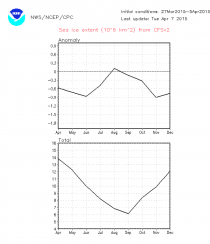Joseph D’Aleo and Joe Bastardi, Weatherbell Analytics LLC
See this story on why arctic ice changes can be explained totally with natural variability - cycles in the oceans and sun. I have extracted a short segment from that story and added to it.
See how well arctic temperatures correlate with ocean (Pacific Decadal Oscillation or PDO and Atlantic Multidecadal Oscillation or AMO) and solar (TSI) cycles.
In the record-setting (since satellite monitoring began in 1979) summer melt season of 2007, NSIDC noted the importance of both oceans in the arctic ice.
“One prominent researcher, Igor Polyakov at the University of Fairbanks, Alaska, points out that pulses of unusually warm water have been entering the Arctic Ocean from the Atlantic, which several years later are seen in the ocean north of Siberia. These pulses of water are helping to heat the upper Arctic Ocean, contributing to summer ice melt and helping to reduce winter ice growth.
Another scientist, Koji Shimada of the Japan Agency for Marine-Earth Science and Technology, reports evidence of changes in ocean circulation in the Pacific side of the Arctic Ocean. Through a complex interaction with declining sea ice, warm water entering the Arctic Ocean through Bering Strait in summer is being shunted from the Alaskan coast into the Arctic Ocean, where it fosters further ice loss. Many questions still remain to be answered, but these changes in ocean circulation may be important keys for understanding the observed loss of Arctic sea ice.”
Frances et al. (GRL 2007) showed how the warming in the arctic and the melting ice was related to warm water (+3C) in the Barents Sea moving slowly into the Siberian arctic and melting the ice. She also noted the positive feedback of changed “albedo” due to open water then further enhances the warming.
The International Arctic Research Center at the University of Alaska, Fairbanks showed how arctic temperatures have cycled with intrusions of Atlantic water -cold and warm.
See how the Atlantic has cooled and though the Pacific (PDO) has spiked, there are signs that this is temporary like the late 1950s and it will turn cold again in two years. When both oceans cool, the arctic, we predict will recover. Some may try and delay the truth by adjusting how and where they measure ocean ice (redefining the arctic region or what percentage of ice/ or level of satellite brightness qualifies).
Phil Klotzbach and Bill Gray have a variant of the water temperature based AMO that factors in atmospheric pressure. JB sparked this post with this ‘musings on the arctic ice’, a bit to long to post in its entirety on Icecap.
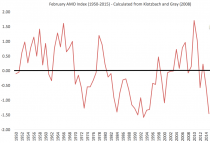
Enlarged
Perhaps the recovery has started.
As JB’s PDF shows, CFS climate model has a higher minimum than 2014 (20%). See his post for how this model has done last year.





